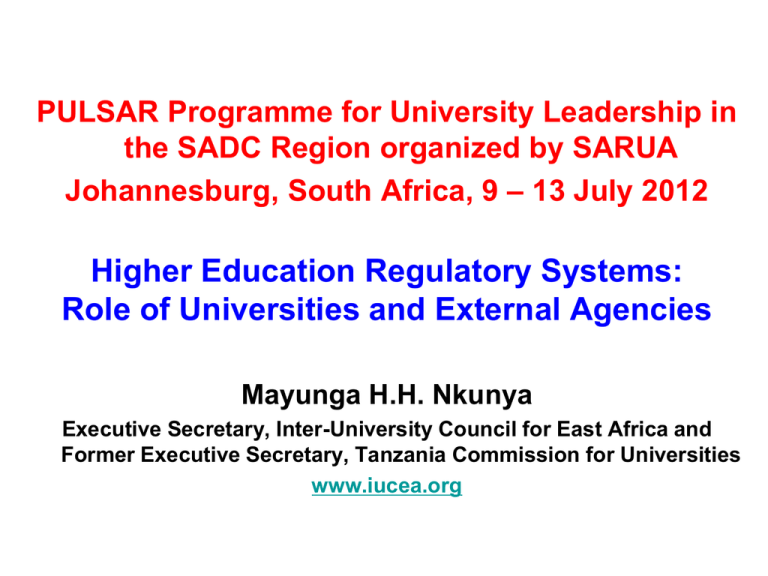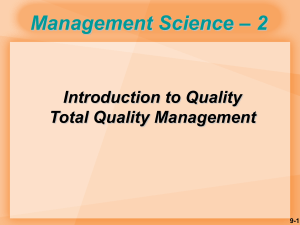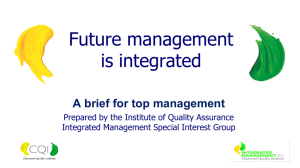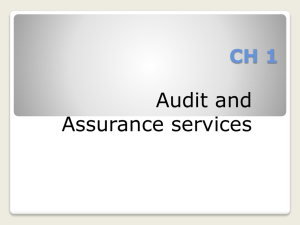Slide 1
advertisement

PULSAR Programme for University Leadership in the SADC Region organized by SARUA Johannesburg, South Africa, 9 – 13 July 2012 Higher Education Regulatory Systems: Role of Universities and External Agencies Mayunga H.H. Nkunya Executive Secretary, Inter-University Council for East Africa and Former Executive Secretary, Tanzania Commission for Universities www.iucea.org Presentation Plan o o o o o o o o o o o Global Trends in Higher Education Future Roles of Higher Education Institutions Future Challenges in Higher Education Quality in Higher Education and Systems Thereof Quality Assurance, Internal and External Evaluation and Accreditation Systems External Quality Assurance Systems in Africa Functions of an External Quality Assurance Agency Role of Higher Education Institutions in Quality Assurance and Accreditation Peer Review Process, and Peer Review System vs External Examiner system Qualifications Frameworks and recognition of qualifications Position of the SADC Region Global trends in higher education • Diverse provision systems and providers • More heterogeneous student bodies, e.g. residential and non-residential, mature, working while studying, without having gone through formal education systems, etc. • Increasing focus on accountability, performance and quality of outputs • Diverse institutional management governance systems • Internationalization and commodification of higher education • Diversity of higher education systems • Emergence of national, regional, international quality assurance frameworks • Ranking of universities based on diverse criteria Regionalization/Globalization and Higher Education Trends Globalization has promoted the creation of regional common market blocks (e.g. EU, AU, SADC, EAC, etc.) characterized by: oNeed for appropriate frameworks for harmonization of education systems and mutual recognition of qualifications to facilitate free movement of human capital, students, study programmes, education providers, etc. oEnhanced regional collaboration in education delivery and crossborder education systems for promoting regional integration requiring harmonized regional systems of higher education, frameworks for quality assurance based on benchmarking, and accreditation systems National responses/interventions… • Education reforms through supportive legislative and policy frameworks • Setting in of liberal education policies promoting public-private partnerships, private higher education provision, and parallel systems of education delivery • Enhancing and diversification of higher education financing through promotion of public-private partnerships, endowment/revolving funds, loan schemes, etc. • Establishment of higher education regulatory frameworks and harmonization of higher education systems and standards at national levels linked to regional/international systems Harmonization framework for higher education as envisioned in the Plan of Action for Second Decade of Education for Africa (2006-2015) - Agree, synchronize and coordinate higher education provision across the African continent - Develop and agree on benchmark standards - Ensure equivalency and comparability of qualifications between and within countries - Avoid disruption, but enhance national (and sub-regional) education systems and programs, instead build on their existing frameworks Harmonization does not entail standardization or achieving uniform higher education system for every country; it emphasizes on respect to national/institutional systems, policies and peculiarities, but advocating on enhanced quality of education Quality in Higher Education No single (simple) definition of quality in higher education, as quality may refer to: o Students and parents views on expected achievement and learning outcomes o Institutional owners commitment to satisfy societal expectations, value for investment, customer expectations, public policies, etc. o Institutional managers achieving missions, adherence to internal policy, accountability to stakeholders, etc. Quality in higher education … Generally quality is a multi-dimensional concept with various interpretations, such as: o o o o o o o Excellence Perfection Value for money Transformation Meeting customers needs Conformity to standards Fitness for purpose and fitness of purpose Quality in higher education … o Quality as excellence: A traditional university view as a goal for being “the best and special” with exceptionally high standards of academic achievement: May not be appropriate to mass higher education provision, since it can lead to exclusivity and elitism: excellence by definition is only attainable by few ! o Quality as perfection: Applied in manufacturing where quality is viewed in terms of consistency through perfectly meeting a given set of specifications with zero defects: o Inappropriate to inputs and products of higher education because students and graduates are never identical Quality in higher education … o Quality as value for money: Quality assessed with respect to return on investment or expenditure: linked to accountability to public expenditure where students, parents and owners of higher education institutions consider the value for money of their investment Applies to higher education o Quality as transformation: Quality as change from one state to another with added value, focusing on the transformation brought to students by learning and ultimately empowering them with new knowledge, skills and competences Applies to higher education Quality in higher education … o Quality as conformity to standards: A quality control approach where an institution is considered as a quality one if it meets pre-determined standards, thus ensuring that institutions or programmes meet certain threshold levels May apply to higher education provided that the standards are just benchmarks, and hence not aquality control approach per see Quality in higher education … Quality as ‘fitness for purpose’ and ‘fitness of purpose’ oFitness for purpose refers assessing as to what extent the intended outcomes in higher education are being achieved oQuality in the context of fitness of purpose means relevance and responsiveness to national and societal needs Therefore quality may be regarded as fitness for purpose as well as fitness of purpose Most acceptable definition of quality in higher education Quality Assurance o Quality assurance means a planned and systematic review of an institution or programme to determine maintenance and enhancement of acceptable benchmarks o Quality assurance can be considered to mean all policies, processes and actions through which the quality of higher education is measured, maintained and developed o It is a systematic and continuous attention to quality and quality improvement: It is not a one time event but a continuous process! Quality assurance has two components … Internal quality assurance: The institution’s mechanisms to ensure and improve its own quality External quality assurance: Monitoring the quality of higher education at institutions by external quality assurance agency, e.g. national commission/council for higher education In some countries such external agents can be either public, private institutions or both (see later) As quality in higher education is the responsibility of the institution external quality assurance systems require higher education institutions to set up appropriate internal quality assurance systems, structures and mechanisms Need for External Quality Assurance Agencies • Liberalization of higher education led to emergence of private higher education institutions with diverse quality standards • Upon proliferation of private higher education providers in Africa, there was need to regulate and coordinate the up coming private higher education providers • This needed establishment of (government) institutions that would regulate and coordinate the establishment and functioning of private higher education institutions so that their adherence to quality and national values could be monitored and appropriately guided Need for External Quality Assurance Agencies … • Hence higher education agencies were established under various names: councils for higher education, commissions for higher education, accreditation councils, etc. • Initially, the main purpose of the higher education agencies was to regulate private institutions rather than to enhance accountability and quality improvement Need for External Quality Assurance Agencies … • Public universities that had been established by their own legislations were presumed not to be covered by the regulatory systems, despite the fact that legal instruments establishing the regulatory agencies gave the agencies mandate to regulate all university institutions. • That caused friction between university senates/management and the regulatory agencies, which in a way tended to jeopardize the authority of the regulatory agencies even among private universities Need for External Quality Assurance Agencies … • Tension between public universities (and private universities) and the regulatory agencies was caused also by the approach that some of the regulatory agencies used to deal with universities, as in many cases it was a policing style and show of mighty rather than a quality improvement approach • This might have been the case because some of the staff who ran the quality assurance agencies were drawn from school inspectorate departments of ministries of education, with little or no experience on university systems and the institutional autonomy and academic freedom that universities enjoy. Later developments …… • Due to globalization and the fact that higher education expansion also involved establishment of new public universities a number of African countries saw the need to enhance the role of regulatory agencies in public universities, by the public universities being treated the same way as the private ones. • In addition some agencies were not only regulating the quality and functioning of universities, but they were also providing advisory services to the governments, and were giving strategic support to the universities, in terms of capacity building programmes, training in curriculum development, in quality assurance regimes, etc. • Some were even coordinating admission of students into higher education institutions so as to maintain uniformity of the quality of incoming students • In many quality assurance agencies in Africa most of these arrangements continue to be applied to date Later developments …… • • • • Some of the agencies were and still continue to license new university institutions, either only private universities, or both public and private, allowing them to operate in the country. In a number of countries no new academic programme (s) can be offered without the approval (accreditation?) of the national regulatory agency They also carried/continue to carry out periodic institutional evaluation (audit) leading to accreditation or otherwise Legal mandates gave/continue to give some regulatory agencies powers to suspend an institution from operating in the country, or to close it altogether. Later developments …… • • Operations of some regulatory agencies are discriminatory between local institutions and foreign ones operating in the country, on the assumption that foreign institutions are always of good quality since they would have undergone rigorous scrutiny by systems in their home countries Some agencies also undertake recognition of qualifications obtained overseas and act as agents for recognition of qualifications from national institutions for external organizations, or from overseas for use by local organizations Accreditation o Accreditation means a process of formal recognition of a university, university college or other degree-awarding institution or study programme as having met predetermined benchmark standards o It is a quality assurance tool for evaluating the quality of a higher education institution or a programme to formally recognize it as having met benchmark (minimum) standards of quality o Accreditation is a periodic undertaking of an external quality assurance agency as assurance on adherence to quality o Its is the ultimate goal of a quality assurance system which gives incentive to the system of quality assurance o There is interchangeable use of terms that refer and those not refering to accreditation per see, such as quality assurance, recognition, licensing, chartering External quality assurance agencies and higher education systems • External agencies are supposed to ensure that higher education institutions and/or programs meet benchmark standards set at national, and/or regional, and/or international levels • They provide public assurance of quality, hence ensuring accountability of higher education institutions to the stakeholders through promotion of quality improvement culture • They help higher education institutions and their programs to move in a set direction towards continuous quality improvement using the set quality assurnce systems • However, quality assurnce is just the means and not the end product of the entire process The end product is stakeholder satisfaction An external quality assurance agency should be … o Independent with autonomous responsibility for its operations, the operational independence being ensured through a legal framework that clearly describes the agency’s mandate o Comprised of a governing board from various sectors that represent higher education stakeholders o Have sufficient level of autonomy ensuring independence o Operating under an appropriate quality assurance framework that is sensitive to local context and is consistent with international practices o Have transparent procedures so as to ensure accountability o Adequately financed o Competent with its staff and external reviewers being people of unquestionable integrity o Continuously reviewing the impact of external quality assurance processes on the higher education system it oversees Functions of an external quality assurance agency o Developing standards and procedures for self-assessment and external review o Manage data on higher education institutions o Selection and training of external reviewers o Liaise with higher education institutions on the quality assurance processes and site visits o Monitor, make decision and report to the public on key quality outcomes o Manage appeals of higher education institutions (if any) o Organize capacity building interventions o Promote external relations and networking with other quality assurance agencies Africa’s external quality assurance systems • Government registration or licensing systems within a national legal framework: These mainly operate in Francophone and Lusophone countries • Ministry of Education recognition on a functional level, i.e. in a department within the Ministry of Education: These operate in Francophone and Lusophone countries • Semi-Autonomous Quality Assurance Agencies that are governed and protected by specific legislation: These are found almost exclusively in Anglophone countries, and follow the European model Accreditation systems • Professional associations often accredit their programs, sometimes in collaboration with national regulatory agencies while others recognize accreditation done by the national regulatory agencies only • Some are incorporating American elements of course credits, continuous assessment, semester systems. • Regional systems are emerging in Africa, such as those by SARUA/SADC, IUCEA, etc. but until now there are no regional system in other parts of Africa, North Africa is served by the Arab system that extends to the Middle East • No regional systems in Anglophone West Africa • CAMES operates in 16 Francophone African countries and has now taken up the quality assurance and accreditation portfolio Should regional accreditation systems be introduced in Africa? If so how should they operate? Features of African Accreditation Systems In Africa External quality assurance agencies can: • Cover only public institutions, only private institutions, or both • Accredit institutions, or programs, or both • Accredit degree programs, non-degree programs, or both • Determine equivalence of foreign credentials • Regulate cross-border higher education • Regulate criteria for student admissions, degree classifications academic staff promotions, etc. Accreditation is normally compulsory and not voluntary External quality assurance agencies are closely linked to Government Assessment features common to most external quality assurance systems in Africa • Assessment of to what extent mission and vision statements (fitness for purpose, fitness of purpose) hare being pursued • Assessment of academic programs • Physical infrastructure: Library, physical and technical resources • Staff: number and qualifications • Students: numbers and admissions requirements • Financial resources per student • Transparency in publication of Results published • Some are also involved in vetting qualifications of students being admitted in higher education institutions Assessment features common to most external quality assurance systems in Africa … • Availability and adherence to policies and procedures for internal quality assurance systems • Consistent application of agreed quality assurance criteria and procedures • Quality of academic staff • Resources to support learning assured • Effective institutional management and governance systems • Periodic publications on quality of courses • Student evaluations (of course programmes) and students assessment processes Requirements for external quality assurance and/or accreditation • Every university is supposed to conduct an institution-wide selfassessment of its operations, prepare a self evaluation report which is then submitted to the external agency as a basis for carrying out an external assessment leading to quality improvement and/or accreditation • After external evaluation the higher education institution is expected to prepare a quality improvement plan that will address recommendations by the external agency on quality improvement • In some cases External Agencies require higher education institutions to cover the costs of the team of external experts • Higher Education Institutions are require to keep documentary evidence on their quality assurance systems and other operations, as these would be needed by External Agency Uncommon features related to accreditation in African • Linking the outcome of quality assessment and government funding allocation • Linking quality assessment to the quality and level of outputs in terms of graduates and research output and quality Is it appropriate to build links of quality assessment to funding allocation and quality and level of outputs for quality improvement and increased accountability of universities in the SADC region? Impact of External Assessment and/or Accreditation • Promotion of higher education differentiation by incorporating diversity in types of institutions, courses, delivery mechanisms and institutional benchmarking • Integration of higher education systems promoting mutual existence of public and private higher education and easing transfer of credits, etc. • Enhanced employability of graduates, raised employer attitudes (especially in respect of private HEIs) due to enhanced stakeholder confidence Private accreditation agencies • They operate in Europe and North America • Some of them are bogus institutions set for the purpose of accrediting degree (diploma mills), and hence may even be own by the degree mills Should private accreditation agencies be allowed to operate in Africa? Peer review process • A peer in the context of quality assurance in higher education is a person who understands the context in which a quality review is being undertaken and is able to contribute to the process • Peer review is the process of evaluating the provision, work process, or output of an individual or collective higher education system operating in the same milieu as the reviewer(s) • Although universities are required to carry out own self assessments as part of a quality assurance process, an external assessment by an expert team (peer review) is an additional instrument to learn more about the quality in the institution The peer review process …… • External assessment gives authority to the outcome of selfassessment • Also external assessment delivers confidence to stakeholders, provides evidence of quality to the public, and shows that the standards agreed upon by the competent authority (External Agency) are being implemented • Provides mechanism for continuous quality improvement in the sustainability and development of the program and buffers against pressures to lower quality standards • Therefore, at the end of a peer review process the higher education institution is supposed to prepare a quality improvement plan based on the peer review recommendations The missions for an external expert (peer review) team • Listens to the faculty and act as colleagues, using their expertise and experience to offer advice and recommendations • Writes a report that might be made public or remains confidential, but the team has to give in its report independent verdict on the quality of the higher education institution • Is bound to confidentiality about everything the team will hear or read about the quality of the program or institution under assessment Composition of an external expert team • A chairperson, who is totally independent of the programme or institution being assessed, and does not need to be an expert in the field being assessed, if possible should have experience in management structures in higher education institutions and with the developments that have taken place during the last few years • Two experts in the programme subject area/discipline of the institution • An expert from the labour market area taking up graduates and/or from the professional association • An expert on education/learning process • An official from the national quality assurance agency who will be secretary • A student? Peer Review vs External Examiner System • Most universities in Eastern and Southern Africa run an external examiner system at the end of every academic year • The perceived role of the external examiner is to evaluate and advise the university on the quality of the teaching and learning process based on evaluating examination papers, performance of students in examinations, fair marking of student scripts, etc. • The duration of an external examination process being not more than one week makes it difficult for the external examiner to carry out an objective evaluation of the teaching and learning process for quality improvement Should the peer review process replace the external examiner system in the long run? Should the peer review process run in parallel with the external examiner system? How should they run together? The need for regional quality assurance systems Through regional quality assurance systems it is possible to set common regional higher education quality standards as a process of harmonization of higher education standards and promotion of institutional benchmarking Promote regional/international comparability and compatibility of higher education Promote and enhance regional/international student and staff mobility, and labour mobility of graduates Promote National, regional and internationally competitiveness of higher education products Institutional accountability to national/international stakeholders through the promotion of institutional competitiveness at regional level Should regional quality assurance systems be used for regional ranking of higher education institutions? The qualifications recognition dilemma • The introduction of an accreditation system is supposedly expected to streamline recognition of qualifications obtained from accredited institutions • However, with the advent of bogus higher education providers or for profit private higher education, coupled with the emergence of quack accreditation agencies, recognition of qualifications even from the so called accredited institutions is no longer automatic! • The question presently being asked in the recognition process is: Is the degree recognized in the country where the qualification had been awarded? • The development of regional economic blocks like SADC, EAC, COMEA, ECOWAS has brought about the necessity of establishing appropriate frameworks for recognition of qualifications obtained locally and from other countries • Hence the need to establish national and regional qualifications frameworks Position of the SADC Region • SADC aims to establish a strong regional cooperation • There is a SADC Protocol on Education and Training and SADC is working for a harmonized quality education system – common QA criteria, procedures and guidelines • Establishment of a framework for comparability of qualifications to facilitate free movement of students, teachers, academics, researchers, trained labour in the region. • SADC is contributing to the AU initiative for harmonization of education in Africa What is a qualifications framework? • Qualifications framework means an instrument for the development and classification of qualifications according to a set of criteria for levels of learning and skills and competences achieved • SADC Countries have spearheads establishment of national qualifications frameworks and a regional framework onto which the national frameworks are linked National Qualifications Frameworks • The importance of national and regional qualification frameworks is steadily growing both globally and in Africa • IUCEA is currently preparing and East African qualifications framework as a generic instrument onto which the national frameworks will be anchored • Qualifications frameworks provide for the alignment of education levels (degrees, credentials, qualifications) with expected student competencies and learning outcomes • Qualifications frameworks are used for both internal (career paths, professional licensing, transfer credits, articulation in study programmes, recognition of prior learning) and international purposes. • Qualifications frameworks offer reciprocity and reliability across countries as students move internationally and want to carry their credits and credentials with them (CHEA, Inside Accreditation, vol 5, No 5) • SADC is leading the development of an African qualifications framework? THANK YOU FOR YOUR ATTENTION






